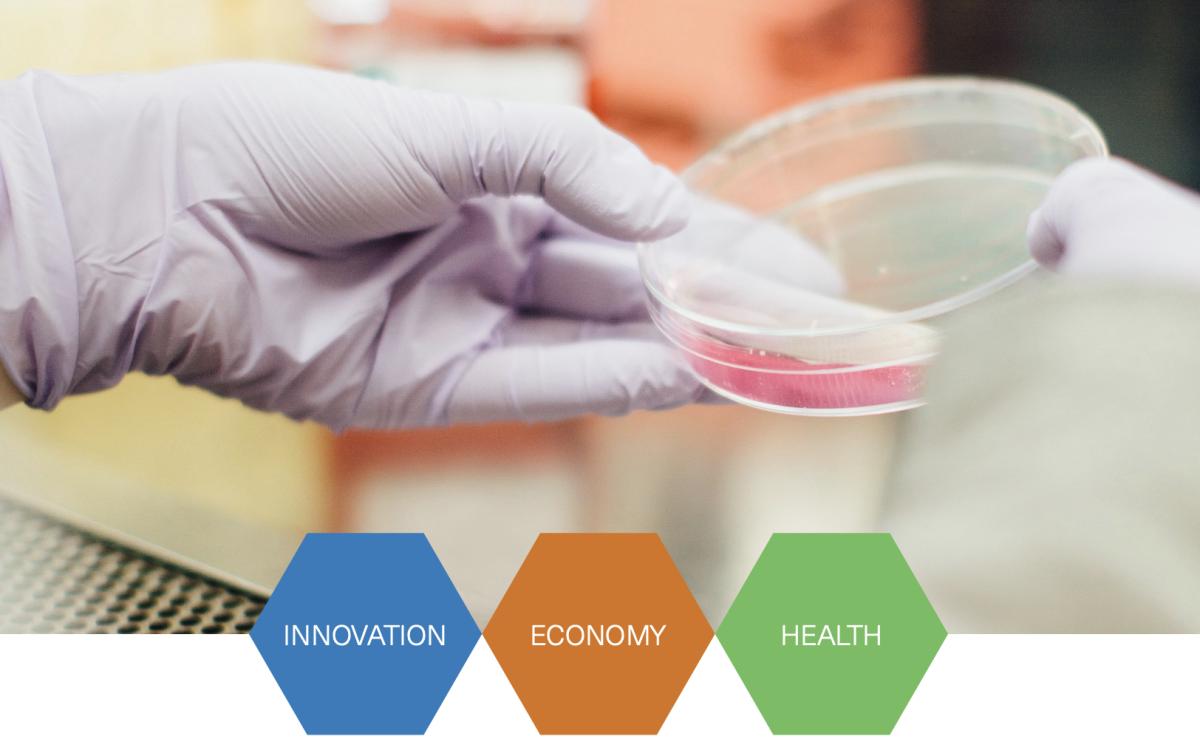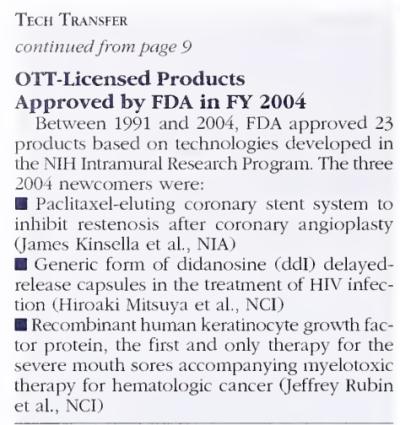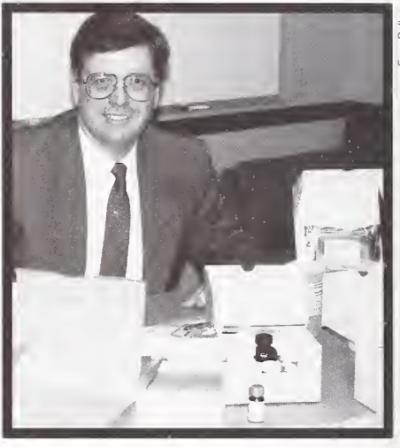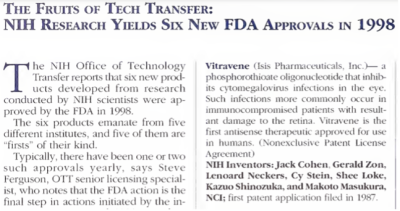Technology Transfer
Making the Transfer from Bench to Bedside a Reality
BY NIH CATALYST STAFF AND ADAPTED FROM THE JOURNAL OF TECHNOLOGY TRANSFER
The NIH Catalyst is commemorating 30 years of publishing with a series of updates to past coverage. In this issue, we highlight the exceptional evolution of technology transfer at NIH and celebrate how brilliant ideas can be translated to clinical breakthroughs.

CREDIT: NIH OFFICE OF TECHNOLOGY TRANSFER
NIH’s intramural licensing impact study describes how the technologies invented at the Intramural Research Program at the NIH generate benefits to public health, economic growth, and the biomedical innovation system.
Role of public-sector research for new drugs and vaccines
Behind the genesis of any new drug or biomedical innovation is often an intricate backstory, a process historically thought to be carried out in the halls of deep-pocketed private biotech enterprises. However, a new study led by NIH researchers shows that public-sector research institutions (PSRIs), particularly the NIH, play a significant part in the worldwide ecosystem of drug development (J Technol Transf 2023; DOI:10.1007/s10961-023-10007-z).
The authors, who include Sara Dodson and Mark Rohrbaugh from the NIH Office of Science Policy, found that a remarkable 364 drugs approved by the Food and Drug Administration were discovered in whole or in part by PSRIs. NIH tops the list at 27 drugs discovered, which includes the chimeric antigen receptor T-cell cancer-therapy drug Abecma from Bluebird Bio, used to treat multiple myeloma.

CREDIT: THE NIH CATALYST
In an article from the 2005 May–June Catalyst titled “From Bench to Tech Transfer and Back to the NIH Scientist”, then-OTT Director Mark Rohrbaugh emphasized that NIH researchers are the heart of tech transfer—from the point of discovery through the successful introduction of a new therapy into clinical practice.
In this study, the term PSRI broadly included universities, research hospitals, not-for-profit research institutes, and government laboratories worldwide that contributed to products approved by the FDA. The term "drug" referred to any product that received marketing approval from the FDA Center for Drug Evaluation and Research or the Center for Biologics Evaluation and Research.
Included were small-molecule drugs, including over-the-counter drugs, protein-based biologic drugs, vaccines, and in vivo diagnostics. Not included were serum-derived biologic drugs, insulin, warfarin, levodopa, or the early vaccines and antibiotics discovered in PSRIs pre- and immediately post-World War II.
The investigators used new and existing methods that captured a broad range of relationships and included drugs receiving FDA approval through 2016. They used four major sources—such as the FDA’s Orange Book, which provides a listing of patents protecting approved drugs—that accounted for a total of 246 drugs. The remaining 118 were identified by other sources such as press announcements, litigation, and conversations with colleagues.
By casting a broad information-gathering net, the authors said that their research provided the most complete compilation of drugs owing their origins to PSRIs.

CREDIT: THE NIH CATALYST
A story in the 2005 May–June Catalyst titled “From Bench to Tech Transfer and Back to the NIH Scientist” reported on new technologies developed at NIH including a coronary stent system, a treatment for HIV infection, and novel therapy to address certain side-effects from blood-cancer treatment.
Particularly noteworthy are the 23 vaccines. Nearly all important, innovative vaccines introduced over the past 30 years were invented by PSRIs, a trend continuing up to the response to the COVID-19 pandemic and including Moderna’s mRNA COVID-19 vaccine, which was developed in partnership with NIH.
Indeed, the NIH dominates the list of FDA-approved vaccines, also contributing to the development of vaccines against human papillomavirus (HPV), rubella, pertussis, Type B Haemophilus influenzae, rotavirus, and hepatitis A, to name just a few; and these in addition to technology for ensuring vaccine safety.
Similarly, two-thirds of all FDA-approved drugs had their origins in U.S. public-sector-based research. The next most prolific countries—Canada and the United Kingdom—each discovered around 5 percent of the total.
A culture of invention
Technology transfer at NIH goes way back. More than 25 years ago The NIH Catalyst (March-April 1997, pages 1-6) reported on NIH inventions, notably, an HIV antibody test developed by the National Cancer Institute’s Robert Gallo, and CHAPS, a zwitterionic detergent used in labs worldwide to purify proteins from Leonard Hjelmeland of the Eunice Kennedy Shriver National Institute of Child Health and Human Development.
Following the creation of Cooperative Research and Development Agreements in 1986, the NIH Office of Technology Transfer (OTT) patent license royalties exceeded patent expenses for the first time in 1996; and in that 1997 article, Steven Ferguson, now a Special Advisor at OTT , commented on how tech-transfer activity directly benefits the scientific community: “Not only does it bring inventions to the bedside, ...money is plowed back into the institutes. It incentivizes the system,” he had said.

CREDIT: THE NIH CATALYST
A photo from the 1997 March-April issue of the Catalyst showing the Office of Technology Transfer’s Steve Ferguson and some of the products he negotiated.
The impact of NIH innovation gains momentum
In June 2023, NIH’s long-anticipated intramural licensing impact study was officially released in conjunction with the BIO Annual Meeting and is now posted to a special section of the NIH Community Tech Transfer Website.
The year-long study involved a full download and analysis of NIH licensing data and demonstrates the true impact and power that NIH’s intramural licensing program has had in three major areas:
- Innovation: NIH licensees cited 148 NIH patents on more than 1,700 patents of their own, and NIH drug discoveries were used in nearly 1,200 clinical trials.
- Economy: Sales of NIH licensed products supported an average of nearly 75,000 positions each year between 2001 and 2021. Aggregate sales in the United States alone totaled more than $130 billion through 2021.
- Health: More than 26,500 deaths from cervical cancer will be averted in the United States alone as a result of the introduction of the Gardasil HPV vaccine—just one example cited.
“It’s an amazing story and it’s also our story,” said Ferguson.

CREDIT: THE NIH CATALYST
In 1998, NIH research from five different institutes yielded six new FDA approvals, reported in the 1999 March–April Catalyst: Included were a rotavirus vaccine; a monoclonal antibody for the prevention and treatment of respiratory syncytial virus; a combined diphtheria, tetanus, and acellular pertussis vaccine for use in infants and children; a compound to inhibit cytomegalovirus infection in the eye; a radiopharmaceutical used to detect deep venous thrombosis.
The full impact report, summary brochure, and case studies can be found at https://www.techtransfer.nih.gov/reports/public-health-and-economic-impact-study.
To read the FY2022 NIH Tech Transfer Annual Report go to https://www.techtransfer.nih.gov/sites/default/files/documents/pdfs/FY2022%20Annual%20Report.pdf.
Interested in more tech transfer? On September 22, 2023, at 10 a.m. in Lipsett Amphitheater, Distinguished Investigator Carlos Zarate will deliver the 16th Annual Philip S. Chen Jr. Ph.D. Distinguished Lecture on Innovation and Technology Transfer. Zarate is Chief of the Section on Neurobiology and Treatment of Mood Disorders and Chief of the Experiment Therapeutics and Pathophysiology Branch at the National Institute of Mental Health. He will present a talk titled “Developing Novel Medications for Treatment-Resistant Depression and Bipolar Disorder.” Watch the lecture online at https://videocast.nih.gov/watch=49943.
This page was last updated on Friday, September 8, 2023
